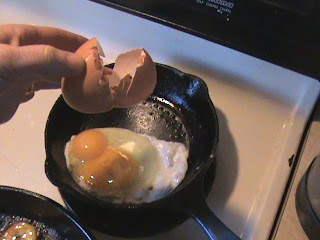There are eggs galore here in Irish Grove.
“Ooh, aah.”
With some forethought and a little luck o’ the Irish, we timed our replacement pullets rather well this year. Since the hens take a much-needed break from egg laying in the late fall, we have a really tough time filling our regular egg orders. Let me tell ya, it can be mighty frustrating to have a barn full of chickens and find 2 or maybe 3 eggs in the nests each day.
And I always wonder if our egg customers believe me when I explain to them that the hens just aren’t laying right now. Egg production is seasonal. The hens need lots of light stimulation on their pituitary gland in order to lay regularly. The short winter days just don’t provide enough light to keep them going. We keep a light on in the barn to help counter that, but like everything else, artificial just can’t compete with the natural.
Can I repeat that?
Artificial can’t compete with natural.
Thanks.
Anyways, spring is the season for high egg production. Which is why we color eggs for Easter and not Thanksgiving.
We mucked through a month or so of little to no eggs as best we could, and I got to wondering if maybe the pullets (young hens) were gonna hold off until spring to start laying. But then, all of a sudden, we started finding little mini eggs here and there. Yeehaw, the pullets are laying!
Now, unless you’ve raised laying hens sometime in your life, you probably didn’t realize that you can tell the age of the chicken by the size of their egg. Yeah, nature is all neat and tidy like that.
Sometimes.
Pullet eggs are tiny. So tiny, in fact, that when I found an aqua-blue pullet egg (from an americana hen that lays greenish blue eggs), Madelina argued with me that a Robin must have layed an egg in the chicken barn. I tried to explain to her that Robins don’t lay eggs in the winter, and that most of them migrate South.
She wouldn’t buy my explanation for one second. Stinker.
Pullet eggs will often have a little splash of blood on them as well. Mothers, I’m sure you will readily confirm that that first one is a tough one. (Sorry, guys.)
More seasoned hens lay nice large eggs. The size of egg you ideally buy from a local farmer, or at the store. These eggs are by far the most common egg we find in the nests. And it doesn’t take long for a pullet to close the gap, size-wise, with her eggs. Maybe 2 weeks, tops.
But the old hens? The ones you should cull and sell as stew birds, but can’t because you believe they’ve earned their retirement? The ones that are losing money beak over claw? Yeah, these old ladies lay an egg maybe once a week, if you’re lucky. Even during egg season. But when they do lay an egg, they are huge, honker eggs. Huge-mongous eggs. The eggs that make it hard to close the carton eggs. Jumbo eggs.
And once in awhile……and I mean these ladies must be sitting on their eggs for a month or so…..they’ll lay a super DUPER doozer of an egg–a double-yolker. And we call these eggs, courtesy of my Gramma Alice, “Ooh-Aah” eggs.
Why, you may ask? Please, you’ve just gotta ask me why, ’cause I can’t wait to tell you.
Gramma Alica calls the double-yolked eggs “Ooh-Aah” eggs because when the hen is pushing the egg out she says, “OOOooooooooh”, and when the egg is finally out she says, “AAAaaaaaaah”.
Ha, ha ha ha, hoo hoo, ha!
I think that’s pretty funny.
Here are some photos of eggs, progressing in size from pullet eggs to an “Ooh-Aah” egg. The photos don’t do this subject justice, but I haven’t added photos in awhile, so here they are:
The pullet egg:
The “Ooh-Aah” egg:
As you can see, I am cooking platanos con huevos fritos for breakfast. In Panamanian that means fried plaintains with fried eggs. Yu-u-mmy!
My (delicious) breakfast is providing the perfect opportunity to prove to you skeptics out there (and don’t think I don’t know about you) that yes indeed, some eggs have two yolks.
Watch. And. Learn.
Here I go, cracking that “Ooh-Aah” egg you saw above:
There you have it, people. A double-yolked egg. An “Ooh-Aah” egg in the flesh, or pan, as it were. Ok, so I did break one yolk when I cracked the egg shell. But you can obviously see that the two yolks came from the same egg….just look at the egg white.
You better believe that with a breakfast like this one, I’ll be muttering a few oohs and aahs myself.
Let’s just hope there’s no accompanying egg.




